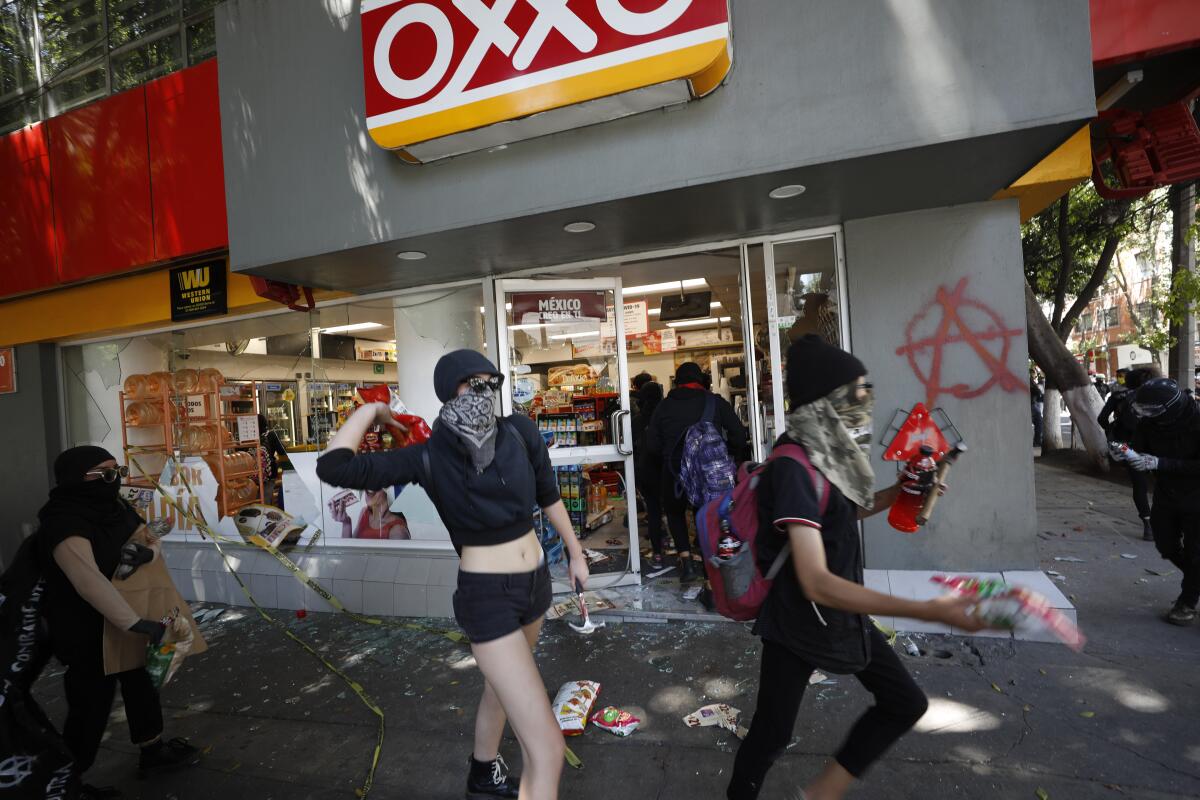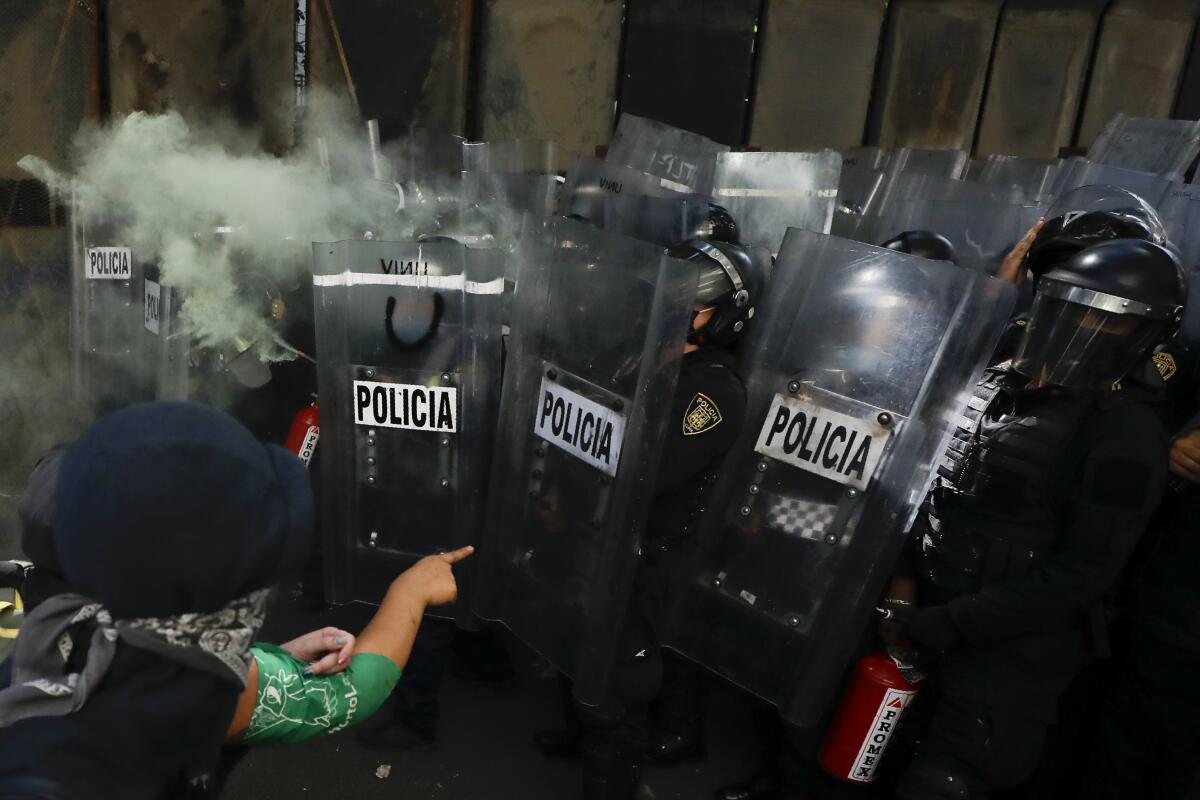U.S. protests prompt reflections on class, race and police violence in Mexico

MEXICO CITY â A group protesting the death of a 30-year-old man in police custody torched a pair of law enforcement pickups, broke windows and vandalized a government building, amid waves of police tear gas.
The tumultuous scene Thursday mirrored episodes of violence that accompanied peaceful protests in U.S. cities in recent days. But in the case of Giovanni LĂłpez RamĂrez, the action unfolded in the historic center of Guadalajara, Mexicoâs second most populous city.
The events followed a social media campaign that likened the fate of LĂłpez to that of George Floyd, whose death while detained by Minneapolis police has resulted in murder charges and fueled outrage about racism across the United States.
Photos of the two men side-by-side have circulated on Twitter, along with the phrase: âGiovanni didnât die, the police killed him.â
The Mexican incident has even had a pandemic-era twist â activists alleged that police initially arrested LĂłpez for not wearing a face mask, a version rejected by authorities.
The civil unrest north of the border has transfixed many in Mexico. The media has featured images of large crowds of protesters and of armored vehicles roaring down U.S. streets.
That turmoil, along with the LĂłpez case and others here, are prompting reflections on the role of Mexican police â as well as the countryâs relationship to race.

âWhen we finish our important support of the anti-racist movement in the United States, can we talk about racism in Mexico?â asked Tenoch Huerta MejĂa, the Mexican star of the Netflix series âNarcos,â in a widely shared video posted online. âOr will it still be taboo?â
While race is often center stage in the United States, discussions of race have largely gone unspoken here. When discussed at all, the concept of race is often interwoven with issues of class.
Mexico officially celebrates its mestizaje, or mixed-race heritage, and takes exception to what many here view as racist treatment of Mexican immigrants in the United States.
âFor a long time, Mexico had a view of itself as not being a racist country â to a large degree because of the contrast between Mexico and the United States,â said Claudio Lomnitz, a professor of anthropology at Columbia University in New York who has studied the issue. âBut that also contributed to a prolonged denial of racism in Mexico.â
Another recent online post, by well-known social media influencer Juanpa Zurita, drew widespread ridicule after Zurita said he didnât understand the racism fueling the U.S. protests.
âIn Mexico we donât experience that kind of thing,â he said.
Detractors immediately pounced on what many called a blind spot in Mexican society.
âThis is what privilege looks like,â wrote cultural critic Fernando Bustos Gorozpe on Twitter, responding to Zuritaâs comments. âSomeone tell him about all the racism and classism that exists in this country that apparently he doesnât see.â
More than a decade ago, then-President Vicente Fox caused a furor in the United States when he declared that Mexican immigrants âare doing the jobs that not even blacks want to do.â The comments were mostly shrugged off in Mexico, where many viewed them as accurate, if inelegantly expressed.
Mexico is home to a small black community, mostly descendants of slaves brought by Spanish conquistadors. Mexicoâs second president, Vicente Guerrero â said to be of partial African heritage â outlawed slavery in 1829, a step that has long been a point of pride in Mexico, compared favorably to belated abolition in the United States.
There was no civil war fought in Mexico linked to slavery, no Jim Crow or U.S.-style civil rights movement. The Mexican Revolution was one of the signature conflicts of the 20th century â but class, empowerment of landless peasants and resistance to dictatorship were at its core, not race.
Still, Mexico has a long history of racial inequality.
Light-skinned descendants of Europeans have historically held disproportionate sway in Mexican politics, industry, academia, entertainment and other fields. Indigenous Mexicans, about 10% of the population, are more likely to live in poverty than mestizos, who make up the majority of Mexicoâs population.
In recent years, there have been growing calls for more cultural representation of indigenous and darker-skinned people in Mexican film and television, which tend to highlight light-skinned actors.
In Mexico, police have long had a reputation of corruption and extrajudicial violence. Surveys show police are among the least trusted of government employees.
The fact that police frequently worked for criminal gangs prompted then-Mexican President Felipe CalderĂłn to send soldiers and marines into the streets to battle drug traffickers in 2006, the opening salvo in the nationâs failed, nearly 15-year-long war on drugs.
A parallel police reform effort pushed by CalderĂłn with aid from Washington also largely flopped. None of his successors has put much emphasis on rooting out corrupt officers, boosting police salaries or improving training.
Huge annual demonstrations honoring the tens of thousands of Mexicans who have been forcibly disappeared often denounce the role of police as gang accomplices.
In Mexico City in recent days, hundreds have gathered outside the heavily barricaded U.S. Embassy. U.S. Ambassador Christopher Landau publicly thanked Mexican police for intervening on Friday âwhen a gang of violent anarchists attacked our diplomatic mission with Molotov cocktails and rocks.â
Some demonstrators proceeded to smash storefront windows along the elegant Paseo de la Reforma and on nearby streets, spray-painting walls with slogans denouncing police and racism.
In Guadalajara on Thursday, about 150 protesters demanding âJustice for Giovanni!â focused national attention on the incendiary case of LĂłpez, an unemployed construction worker who died last month after being arrested in the Guadalajara suburb of IxtlahuacĂĄn de los Membrillos. Protests and media accounts have not focused in the least on his heritage â he was mestizo like most Mexicans; but the U.S. protests over the killing of a black man have nonetheless helped fan indignation.
In a statement, the attorney general for Jalisco state, which includes Guadalajara, said that police arrested LĂłpez on May 4 âfor presumed violent conduct.â Grainy cellphone video of police confronting LĂłpez and forcing him into a cruiser has circulated on social media.
According to local reports, LĂłpezâs brother, Christian, said he witnessed police beating his sibling at the scene of the arrest. When an aunt went to the police station the next morning to inquire about LĂłpezâs fate, she was told he had been sent to a hospital in Guadalajara. Thatâs where he was declared dead on May 5.
A death certificate published by local media declared âtraumatic brain injuryâ as the cause. LĂłpez had also been shot in the left leg, his brother said.
Three police officers have been arrested in the case, authorities say.
On Thursday, police who initially held off from confronting the angry crowd in Guadalajara finally moved in as protesters smashed windows, spray-painted walls and attempted to break down and set ablaze the wooden doors of the colonial-era government complex. Video showed a man dousing a motorcycle copâs back with a flammable liquid and igniting it. Colleagues extinguished the flames as enraged cops manhandled protesters.
In all, authorities say, 28 people were arrested and half a dozen officers were injured.
All were subsequently released, and Jalisco Gov. Enrique Alfaro apologized for police attacks on protesters during a follow-up demonstration on Friday.
Like many of his U.S. counterparts, Gov. Alfaro blamed the protest violence on a familiar culprit--outside agitators.
âThis is a matter organized from the basements of power in Mexico,â the governor declared. âWho paid the millions in pesos in social media fees to construct this story based on disinformation and lies? ... Who are the responsible ones?â
Cecilia SĂĄnchez in The Timesâ Mexico City bureau contributed to this report.
More to Read
Sign up for Essential California
The most important California stories and recommendations in your inbox every morning.
You may occasionally receive promotional content from the Los Angeles Times.











